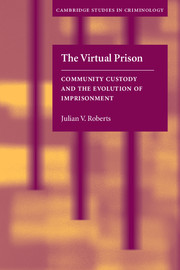Book contents
- Frontmatter
- Contents
- List of figures and tables
- Foreword by Andrew Ashworth
- Preface
- 1 Introduction to the concept of community custody
- 2 The way we punish now
- 3 Conceptualizing community custody
- 4 Representative models of community custody
- 5 Coming home to prison: offender perceptions and experiences
- 6 The effect of community custody on prison admissions
- 7 Public attitudes to community custody
- 8 Making community custody sentences work
- Notes
- References
- Index
4 - Representative models of community custody
Published online by Cambridge University Press: 07 December 2009
- Frontmatter
- Contents
- List of figures and tables
- Foreword by Andrew Ashworth
- Preface
- 1 Introduction to the concept of community custody
- 2 The way we punish now
- 3 Conceptualizing community custody
- 4 Representative models of community custody
- 5 Coming home to prison: offender perceptions and experiences
- 6 The effect of community custody on prison admissions
- 7 Public attitudes to community custody
- 8 Making community custody sentences work
- Notes
- References
- Index
Summary
Many different models of community custody exist. No attempt will be made to describe them all; instead, a number of different versions will be examined, beginning with the conditional sentence of imprisonment created in Canada in 1996. The Canadian incarnation of community custody is particularly interesting as it represents one of the most ambitious forms of this sanction, with a broad ambit of application that includes offenders convicted of the most serious offences, including manslaughter and sexual assault. This feature of the sanction obviously increases the power of the sanction to reduce the number of admissions to custody, but also creates other problems. As well, the successes (and failures) of community custody as a sanction emerge most clearly with this model in this particular jurisdiction. The chapter is restricted to home confinement/community custody regimes pertaining to adults, although analogous sanctions exist in many countries for young offenders (e.g. Smykla and Selke, 1982). For the purpose of elucidation, the Canadian sanction is presented in some detail; for brevity, counterparts in other countries are summarized more succinctly.
Canada: conditional sentence of imprisonment
The conditional sentence of imprisonment was introduced in Canada in 1996, as part of a broader sentencing reform initiative (see Daubney and Parry, 1999; Roberts and Cole, 1999). Although Canada has had a suspended sentence for many years, this is the first time that a community custody sentence has been available to sentencers.
- Type
- Chapter
- Information
- The Virtual PrisonCommunity Custody and the Evolution of Imprisonment, pp. 66 - 91Publisher: Cambridge University PressPrint publication year: 2004

